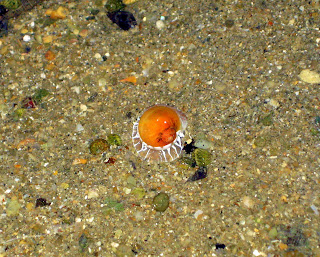The previous post introduced some of the many critters at Tanah Merah, and of course i harped on the rubbish i encountered. to prove my point that Creeper Snails are really everywhere (i have a weird obsession with them im not sure why) :
 Here they are again, crawling all over this poor Sea Urchin, which can be commonly sighted at Changi but hardly at Tanah Merah.
Here they are again, crawling all over this poor Sea Urchin, which can be commonly sighted at Changi but hardly at Tanah Merah.anyways, we also saw some interesting Anemones on the shore:
 like this very plain Anemone above that they nick-named "Bob", due to its lack of features (however, no one has yet to identify it).
like this very plain Anemone above that they nick-named "Bob", due to its lack of features (however, no one has yet to identify it). and this one quietly buried in the sand, waiting to strike. i would have missed it if not for Liana's sharp eyes.
and this one quietly buried in the sand, waiting to strike. i would have missed it if not for Liana's sharp eyes.I especially love this one here. how some of suction/tentacles are opened and some are closed.
For many people like me who didnt know, Anemones arent as innocent as they look. they are actually pretty fierce predators. they look pretty, however, they can sting and release toxins which are highly toxic and likely fatal to fishes and crabs. This gives the Anemones its 'sticky' and kinda soapy feeling when touched.
A particular group of fishes, the Anemonefish (a very creative name), are immuned to their stings. yes, Nemo the clownfish belongs to that group.
Well, since i quoted the Beatles song as my title, i will have to talk about the Coral Garden right next to Tanah Merah Jetty.
its right on the other side of this seemingly friendly seawall:
okay im kidding. please DO NOT attempt to climb this seawall if you are on your own. the stones are coated with algae and sea muck, making it really slimy and slippery.i swear i nearly died climbing over it. i was distracting myself by talking to ivan and he said he would write me a nice epitaph if i die haflway. so, DO NOT climb it on your own. on the other side:
i have to admit it was worth it. i never thought i would ever see something like this in mainland singapore. coral rubble, live corals, rocks rocks and more rocks. it was semi-heaven for me.
These are corals i believe, but i was too far away perched precariously on a lone rock, to take good pictures. i was too scared to step down in case i step on a Stonefish.
and i believe this picture below is a coral rubble:
Im sorry to say this, but i never knew that corals are living creatures till i took the Biophysical Env of Singapore module in NUS. i just thought they were pretty marine structures. BUT i now know corals are alive! and they (*refers to textbook):
- thrive in clear, warm waters and are mainly found in the tropics. (this is where geography comes in!)
- feed on plankton and other tiny swimming animals which they immobilize with their stinging cells (kinda like the anemones)
for more a more detailed post on the Coral Garden, visit Koksheng's blog! i kinda freaked out halfway and went back. so i didnt get the great pictures that he did.
anyways, tomorrow for the geography of tanah merah shore! please stay tuned.
love, serene!
____________________________________________________________________
hi hi hi there!
#2 Rocky candidate
 This rock came from the White Chalk Cliffs of Dover, England. The cliffs are of very fine grained Limestone. If you look at the first picture (Click to enlarge), the grains are really tiny.
This rock came from the White Chalk Cliffs of Dover, England. The cliffs are of very fine grained Limestone. If you look at the first picture (Click to enlarge), the grains are really tiny.This Limestone consist of:
- Calcium Carbonate (the white parts), which depositions of skeletal remains of planktonic algae and other sea-bed dwelling organisms come together to form sediments of CaCO3.
- Flint (the black reflective parts of the second picture)
- Quartz (small colorless crystals of the third picture)
Limestone is a sedimentary rock, meaning it's made of various minerals being cemented together over time. and whats so special about this particular stone is that, the entire cliff was once below the ocean.
Since the calcium carbonate part came from depositions of sea-dwelling creatures, it is evident that tectonic activites over the millions of years uplifted that part of the seabed upwards. and the years of weathering then, exposed the chalk cliff!
Since the calcium carbonate part came from depositions of sea-dwelling creatures, it is evident that tectonic activites over the millions of years uplifted that part of the seabed upwards. and the years of weathering then, exposed the chalk cliff!
beautiful isnt it? (:
Thanks John, you couldnt have chosen a better rock! (:


















































